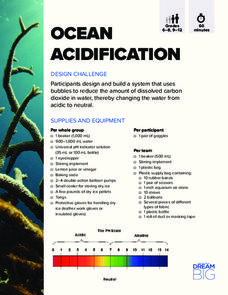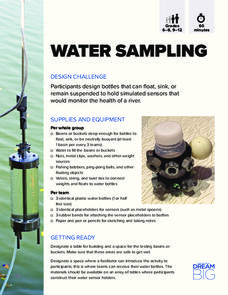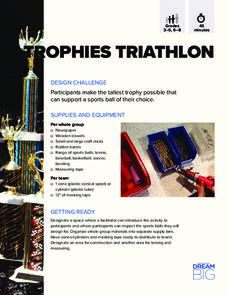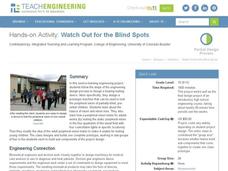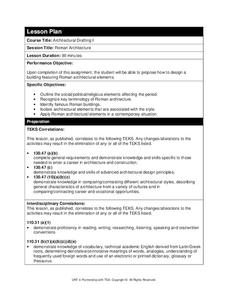DiscoverE
Launch It
Launch pupil interest in rockets. Scholars build rockets out of straws and balloons to learn about Newton's Third Law of Motion. Their task is to hit a target five feet away. It's not as easy as it seems!
DiscoverE
Dance Pad Mania
You'll dance for joy at finding a helpful resource. Learners use their knowledge of electric circuits and currents to create a dance pad. Buzzes or flashes should occur when dancers step on the dance pads—a sure sign they have all the...
DiscoverE
Build a Pinball Game
Watch your classroom turn into an arcade. Pupils work in groups to build pinball machines from boxes and other found objects. Gamers must incorporate a variety of obstacles and launchers into the machine to see their designs in motion.
DiscoverE
Ocean Acidification
Combat ocean acidification with bubbles. Young engineers create a system that reduces the acidity of water. Dry ice in water helps simulate ocean acidity, and blowing bubbles into the water results in a gas exchange that neutralizes the...
DiscoverE
Water Sampling
What is the best way to test water quality? Using plastic bottles, scholars create monitoring sensors to test water quality. Creating three different sensors allows individuals to measure water quality at different water levels.
DiscoverE
Trophy Triathlon Design Challenge
Build a trophy and be a winner. Pupils build trophies that can support a sports ball of their choosing. Based on the ball choice, they figure out how the height requirement changes.
DiscoverE
Extreme Trampolines
You'll bounce off the walls with glee after finding a fun resource. Young engineers design trampolines for golf balls. They build and test out their design and make improvements based on the results.
DiscoverE
Tape Dispenser Challenge
Help your class get out of a sticky situation! Future engineers explore existing tape dispensers and then design a new system for dispensing tape. To put these systems to the test, they build and evaluate prototypes of their designs.
DiscoverE
Sorting Solutions
It's okay to play with your food—just this once! Scholars design and create meshes and chutes to sort pasta by size and shape. They test their designs and make improvements as necessary.
Maker Media
Makerspace Playbook
Make the most of project-based learning with Makerspace. A playbook shows instructors and other interested parties how to set up a Makerspace and Maker community to foster STEM projects. It gives ideas for startup activities and for...
NPR
Share and Reflect
Would you have done anything differently? Groups publish one-minute videos on their engineering solutions to the plastic problems. They self-reflect on their work throughout the unit.
NPR
Communicate the Solution
Communication is key. Scholars produce videos to highlight their engineering solutions to the plastic problem in the ninth installment of the series of 10. Feedback from other groups lets them improve the videos.
NPR
Iterate to Improve the Prototype
Strive for perfection. Based on peer feedback, groups identify ways to improve their prototypes of the solution to the plastics problem. Members must come up with at least two ideas for improvements. This is the eighth instructional...
NPR
Test and Evaluate the Prototype
Time to test the prototype. Groups test their prototypes to the plastics problem under consideration. The results of the tests and peer feedback offer a means to refine the prototype.
NPR
Prototype the Solution
It's always nice to see what the solution looks like. Groups build a prototype of their solution to the plastics problem in the sixth installment of a 10-part unit. The prototypes can be either a visual prototype or a working prototype.
NPR
Brainstorm and Evaluate Solutions
May the best idea win. In groups, scholars brainstorm solutions to the problem statement developed in the previous lesson. The best idea moves forward to the prototype stage.
NPR
Identify Criteria and Constraints
What defines success? The fourth installment of a 10-part series focuses on the criteria for engineering design success in solving the plastics problem. Pupils also consider any constraints.
NPR
Define the Plastic Problem
Individuals identify a specific problem concerning plastics and write a problem statement, which describes the problem, explains why it's a problem, and identifies desired solutions.
NPR
Investigate the Plastic Problem
Plastics are forever. The second lesson in a 10-part unit has pupils research the effects of plastics on the environment. They present their findings by creating an infographic.
NPR
Introduction to the Engineering Design Process
Step by step is always best. In groups, future engineers create the tallest possible tower with marshmallows and spaghetti sticks. Along the way, they learn about the engineering design process.
Teach Engineering
Bone Mineral Density Math and Beer's Law
Hop into a resource on Beer's Law. A PowerPoint presentation introduces Beer's law as part of calculating bone density from X-ray images in the sixth instructional activity in the series of seven. Individuals work on practice problems...
Teach Engineering
Watch Out for the Blind Spots
Applying engineering concepts to the field of medicine, pupils design a device to help test peripheral sight. The class learns and follows a specific design process for engineers before separating into groups; each group builds a...
Texas Education Agency (TEA)
Romanesque Period
What defines architecture from the Romanesque Period? The last installment of an 11-part unit on architecture focuses on elements and examples of Romanesque architecture. Scholars complete a review worksheet after viewing a PowerPoint...
Texas Education Agency (TEA)
Roman Architecture
Design an office fit for the gods. Individuals view a PowerPoint presentation on Roman architecture, its key elements, and famous structures. In groups, they design an office building incorporating the elements of Roman architecture.





